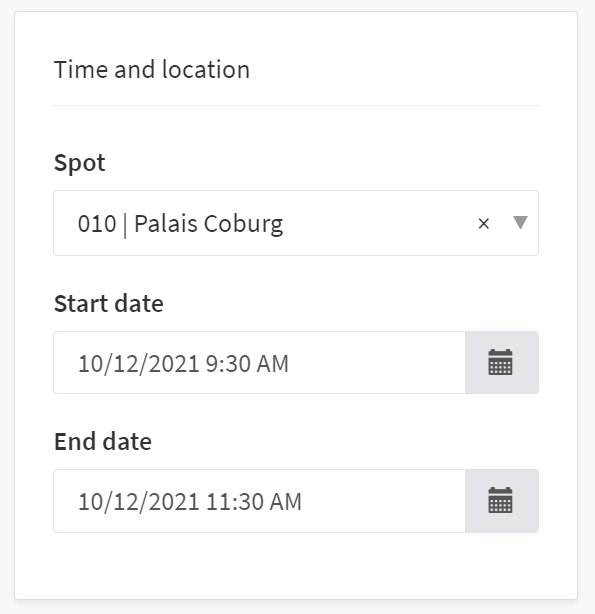We become aware of the event on the smartphone, register with them, and then also use them when we visit a gathering. The “big” computer plays a very small role at events, but the mobile phone is always present and provides huge added value – for organizers and visitors alike.
The uncompromising “Mobile First” thinking by xamoom supports organizers and makes it easy for visitors – regardless of whether it is a virtual event or a real-world event.
For organizers, there are always a million things to do and never enough time for everything. It is therefore important to automate as much as possible. As a user of an app or mobile website, you are always in the picture of what is going on and where and you derive greater benefit from these events.
1. Before the event
An event wants to be promoted on all conceivable channels: from social media and newsletters to your own or external websites and of course your own mobile app.
Every page in the xamoom system can easily be turned into an event with the extension “place and time”. For this purpose, a venue (already set up as a “spot”) is selected and the start and end times of the event are added. Done.

The result is a page (both on the mobile web and in apps) that includes event-specific information and functions.

If the user clicks on the time at the top or the button at the end of the page, the event is entered in the calendar. A tap on the location (above and below) starts the turn-by-turn navigation.

These are two good examples of how we at xamoom see “Mobile First”: Using the entire functionality of smartphones for the benefit of the customer (better for organizers, easier for guests).
Registration with added value
In addition to specific event information, the organizer can also offer RSVP using the form. As in the screenshot above, preferences can also be queried. It is also advisable to refer to the data protection rules and to get the OK for reminders.
xamoom.forms helps the organizer to handle many routine tasks automatically. A form and its workflow only need to be created once (or cloned from an older event) and from then on everything takes care of itself. Here are some examples of such a workflow:
- The organizer will be informed of each registration in a table or by email.
- A reply email confirms the registration of the visitor.
- The caterer can be informed about food preferences. The resource planner receives clues about the popularity of individual topics and can plan with rooms of different sizes.
- Optionally, a payment service can be integrated as well as newsletter registrations.
- The sale of tickets including the automatic issuing of cards and receipts is also conceivable.
- If desired, notifications can be automatically transferred to CRM systems as well as to communication solutions such as Slack or Teams.
The data can be downloaded as a CSV file before the start of the event and then opened in Excel. There they can - nicely formatted - be ejected as an attendance list. Optionally, the data can be deleted in accordance with the GDPR after a set period of time.
Maintain tension
In the period from the first announcement to the event itself, reference can be made to program highlights and the like in several articles in the app or on the mobile web. In this phase, it is more important than ever to report back to the cell phone by e-mail or push message.
In this way, essential event information such as corona rules or dress code are communicated.
2. On the event
xamoom helps to improve the event experience itself. This starts with the (currently still mandatory) Corona Check-In at the entrance.
Push notifications can also be used during the event. xamoom offers four options for this. Why? We want our customers to be as relevant as possible. Nobody who uses the app at home is interested in an on-site announcement. Low relevance often means that apps are uninstalled.

xamoom.messaging: from micro-location to the whole planet
- iBeacon-Push: Relevant content for the respective location – as soon as a Bluetooth transmitter is within range (five to 70 m).
- Geo-Push: A push message to all users who are within a certain location at the time of sending the message.
- Reverse GeoPush: A push message to all users who are right now outside a certain location.
- Push to all: A message to all users of the app – regardless of their location.
During a conference session, speakers could involve the audience and ask their viewpoints. This form of interactivity is very popular because everyone somehow wants to have a say.

Involve your audience: Everybody wants to be a part of it.
Guests could be allowed to ask the speakers. The great advantage of digital submission is that questions can be selected and moderated. This avoids surprises and co-lectures when microphones are passed around.
If a guest has forgotten his/her business cards at a business event, it just doesn't matter. Especially at network events, digital business cards could be prepared for the participants in the xamoom system, which then remain on the mobile phone for a long time. Where? In the wallet, where they are quickly at hand.

No business card with you? The wallet is always with you.
Mark Sampson/AdobeStock
Then there are sponsors who can draw attention to themselves with special campaigns, sweepstakes, or competitions – on mobile phones, of course. As always, the following applies here: the better the prices and the better they are communicated, the greater the want to play. A QR code is more likely to be scanned than a possibly long and cumbersome URL typed in a small browser. NFC tags, iBeacons, or a place at the start screen of the app are also great.
For larger events (e.g. conferences) or those about which many journalists report, a support chat with a digital concierge would be appropriate. With xamoom, this is created using easy-to-create messaging buttons. Alternatively, a professional chatbot like the one from Intercom can be integrated.

A person-to-person chat is incredibly helpful at large events
New Afrika/AdobeStock
3. After the event
An event does not end when the last band no longer gives an encore or the last presenter has left the stage. Then the follow-up begins.
Using an iBeacon at the event's exit invites app users to give valuable feedback. If this is requested anonymously, there are more and more honest answers, which helps to make the next event even better.
At the end of the event at the latest, it would be the perfect moment to distribute digital goodies that remind guests of the event in the future:
- ebooks or PDFs (less optimal on the mobile phone) on the subject as a download,
- further links that were addressed in the context of the lectures,
- playlists of the music played in Apple Music or Spotify or
- contact details and digital business cards of supervisors.
Ultimately, announcements for similar events in the future are the be-all and end-all.
